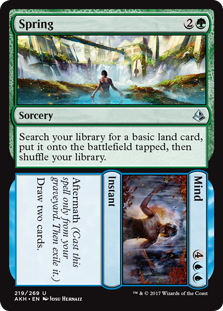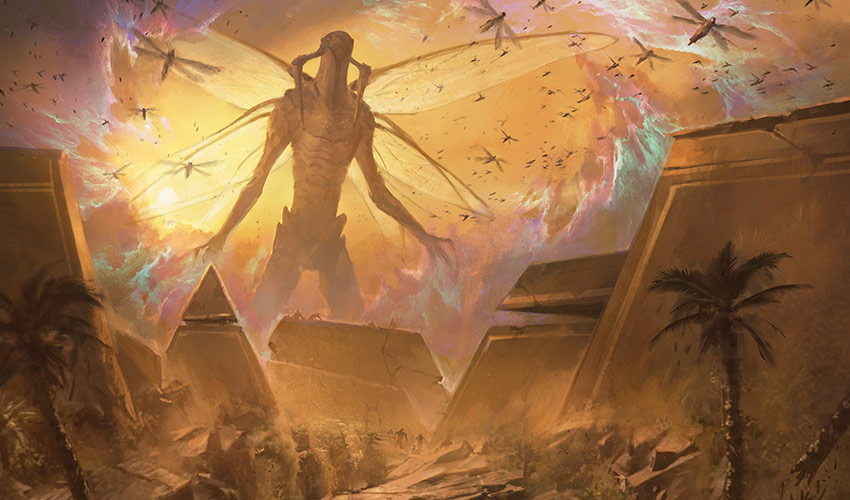If you haven't played the new Bant Approach deck that's been floating around the Standard competitive scene, let me be the first to tell you that you're missing out.
Like any Approach of the Second Sun deck, your primary goal is obviously to cast the second copy of the eponymous card to win the game. But unlike lists that rely on threats like Torrential Gearhulk as secondary win conditions, Bant Approach has a fall back plan that involves zombies. A swarming, relentless tide of 2/2 Zombies to be precise.
After becoming slightly obsessed with the deck a few weeks ago, I've been playing it steadily both on and offline. The steady stream of pilot experience with the deck has shown me how versatile the deck really is. After a lot of tweaking and tuning, the list I've settled on so far is this:
The main cards you need to know about if you're considering running this deck are Hour of Promise, Spring // Mind, and your all-important Desert package. Knowing when and how to utilize these cards will make or break your ability to play Bant Approach successfully.
For example, while Hour of Promise is the linchpin of this deck due to its ability to ramp you up by two lands, you need to be aware of what lands you need. If you control a total of three lands with the Desert after the spell resolves, you get a pair of 2/2 Zombie tokens. While you do want Zombies blockers out, your first use of Hour of Promise is typically going to be used more so for Mana fixing - especially if you don't already have a Desert out.
It's important to remember that this deck wants you to have double white and double blue by turn six at the latest, and to grab those dual lands that would come into play tapped anyway.
[one_third responsive="stack"]
[/one_third]
[one_third responsive="stack"]
[/one_third]
[one_third_last responsive="stack"]
[/one_third_last]
Hour of Promise wants you to run multiple Desert lands, which is where the Desert package comes in. Those Deserts are what gives Bant Approach the ability to change gears almost fluidly, and being able to use them properly (or not) will ultimately determine how successful (or not) you'll be while playing the deck.
Proper Mana management and knowing when you should be activating Shefet Dunes, Hashep Oasis, or Ipnu Rivulet are all key elements of piloting Bant Approach. If I can say any one thing to help tell you when you should be doing what, it would be 'do your combat math'.
Yep – combat math in an Approach of the Second Sun deck. It's important, especially once you start to see some of the possible interactions with the various Desert cards.
For example, after your opponent declares attackers you can create an instant speed 2/2 blocker by sacrificing Dunes of the Dead to Ipnu Rivulet, and a second 3/4 blocker if you have two more Mana to exile Dunes of the Dead to Hostile Desert.
On the offensive, you can animate Hostile Desert by exiling the land you sacrifice with Shefet Dunes in response to its activation and get your now elemental Hostile Desert to swing in as a 4/5 alongside any 3/3 Zombie pals he might have.
[one_third responsive="stack"]

[/one_third]
[one_third responsive="stack"]
[/one_third]
[one_third_last responsive="stack"]
[/one_third_last]
Spring // Mind takes four slots in this deck for two big reasons: First, Spring ramps you up a land. Secondly, and arguably just as importantly, Mind lets you draw two cards at Instant speed.
While you could theoretically replace Spring // Mind with cards like Shefet Monitor, Thunderherd Migration, or Beneath the Sands, if this deck has any inherent weaknesses it would be ramping up into nothing fast due to a lack of gas, and that's a weakness that Spring // Mind is tailor-made to help solve.
Playing the deck is relatively straight forward: Your first two-to-three turns should be spent ramping and mana fixing, ideally leading up to a turn four or turn five Hour of Promise. From there, a plethora of removal spells should keep the board clear while you dig for Approach of the Second Sun. The only cards you can play on your opponent's turn are Cast Out, Mind, Settle the Wreckage, and Essence Scatter.
If the lack of Instant speed answers makes you uncomfortable, this might not be the deck for you. You'll definitely be missing out though.
Moving Scavenger Grounds to the sideboard and replacing it with Hostile Desert was a personal choice, and it's not a mandatory one. The same is true for playing Dunes of the Dead over a sixth basic land.
[one_third responsive="stack"]
[/one_third]
[one_third responsive="stack"]
[/one_third]
[one_third_last responsive="stack"]
[/one_third_last]
Beyond those two choices, I would say that the deck has roughly 2-3 'flex' slots in the main. I chose to use one of those slots to play Wildest Dreams, and it has worked out really well. Cycling early game Cast Outs and knowing that you can recover them later is a mercy, and the same is true for cards you might need to throw into the graveyard with Search for Azcanta.
Competitively speaking, Bant Approach has managed to make a Top 8 showing at three separate PPTQs in the last month. The flex slots that I mentioned previously are Wildest Dreams, the third copy of Gift of Paradise, and whether or not you want to run the fourth copy of Approach of the Second Sun. So if you're looking for room for a card you want to try out, those slots are the easiest to play with.
Cards worth considering playing in those aforementioned flex slots and that are conducive to the Bant Approach plan are Nissa, Steward of Elements, Kefnet the Mindful, Bounty of the Luxa, and potentially some number of Carnage Tyrants in the main. Ultimately, the decision on what to do with those slots is up to you once you decide to play the deck – and you should decide to play it, because it's great!
A video article that spotlights this deck in action is currently in the works, and will be made available for your viewing pleasure in the near future.
Have some more suggestions on what to do with those other flex slots, or comments on experience playing with or against Bant Approach? Let us know in the comments below!
This article originally appeared on MTGeh.com.




